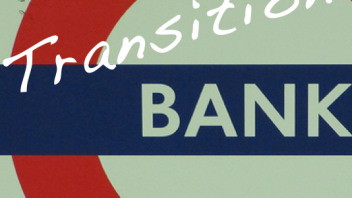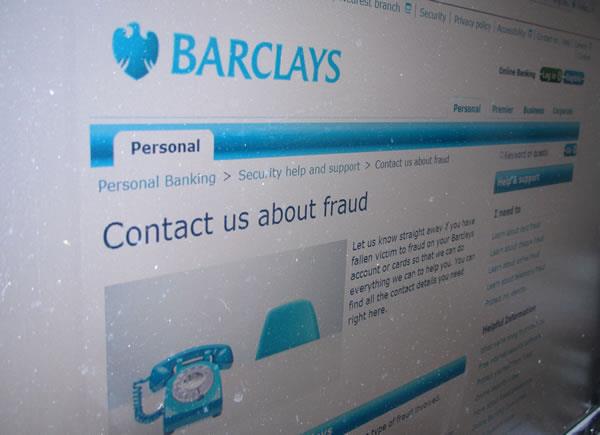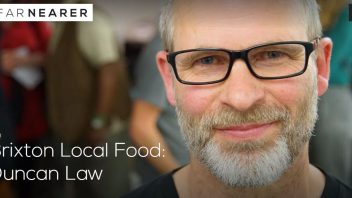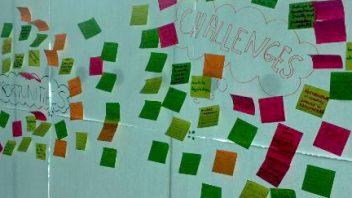
A post by Shane Hughes. Our banks engage in industrial scale fraud and are more destructive than most of us realise, underming the transiton to a vibrant and resilient world. Given that mainstream banking reform fiddles around the edges, should (or could) our community groups proactively create the banks and banking system we want? Here’s my thinking…
With vigor, our entrepreneurs set up energy companies, food coops, bakeries, pubs and repair shops. We’re also gaining valuable skills around emergent financial instruments like local currencies, crowd funding, Timebanks and cooperative investment models. Is it time to apply this entrepreneurial energy, scale up our financial skills and found a Transition Bank? I argue here, that a Transition Bank would be the most strategic enterprise on our High Streets enabling the transition to a new economy, super charging the set up of Transition Enterprises and facilitating strategic initiatives like local currencies and incubators.
In this post i try to define a Transition Bank, I’ve covered the negative impacts of the existing banking system at the end of this post but I wanted to cut to the chase and summarise a proposed Transition Bank, with the following equation;
Lets look at the equation in more detail.
A credit union or similar coop, non profit-type structure – The typical CU structure fits well with many of the criteria for a Transition Enterprise and the Transition Principles especially in the community and profit related areas. It uses cooperative principles where the savers are also owners of the CU and generally speaking, credit unions are of interest to community change-makers because they’re seen as “community-oriented” and “serve people, not profit”.
Transition Principles and the Transition Enterprise definition – What CU’s don’t have by default, is the environmental dimension, which is so important to our current global transition. This is where it is essential to overlay the Transition Principles (and related permaculture principles) and the Transition Enterprise Definition. These offer guidance open to local adaptation. This Transition thinking could be added as part of lending criteria or integrated into the bank’s constitutional structures, legal agreements and founding ethos.
The basic services you expect from a bank – Before getting to the nub of this post and talking about the potential for a Transition Bank to offer new financial services, it’s important to note that CU’s can supply pretty much all the basic services that you get from your High Street bank. In some cases tax exception and volunteer staff enable CU’s to supply these products at more competitive rates than traditional banks and surveys show that they do this with higher levels of customer (owner) satisfaction.
Innovative new finance, trade and exchange models – Where the proposal for a Transition Bank holds disruptive potential is when we add the emergent financial and exchange instruments that aren’t available through traditional banks. What if my Transition Bank Manager could advise me on preparing my crowd funding bid? or my community investment scheme? or perhaps manage my local currency, or maybe handle the transfer of assets into community ownership? Lets look at some of these in more detail.
Community investment instruments like Community Supported Agriculture (CSA) and Industrial Providence Societies (IPS) are increasingly used to fund anything from community energy companies through to farms, bakeries, pubs and more. Here’s some inspirational examples of community investments. A similar thread is Social Impact Bonds (SIB’s). Having a Transition Bank manage the schemes and advise entrepreneurs should reduce the main barrier and accelerate this segment.
Turning from investment models to investors. What if, instead of having a risky casino investment arm, the Transition Bank had an “Impact investment” arm? We’ve seen an upsurge in impact investors, some wanting a venture-capital-for-good approach with financial, as well as, social or ecological returns. Others are looking to get higher yields out of philanthropy. The Transition Bank could be a core tool in a strategic shift towards positive investments, that can democratically shape our communities.
A Transition Bank could further bolster entrepreneurial energies through connected programs that marry impact investors with Transition Enterprise incubators and innovative support organisations.
To lubricate our start ups and to keep our economy circulating Transition Banks could offer a diversity of credit and liquidity routes, essentially traditional loans in not so traditional ways. What if the bank provided a safe and credible mechanism for peer to peer lending and funding circles?
Chris Cook of Transition Linlithgow, who has a City background, advocates a ‘Back to the Future’ return to the use of the long forgotten original ‘stocks’ credit instruments which pre-dated the advent, in the early 18th century, of the system of debt and loans created by modern banking.
Chris sees 21st century Peer to Asset stock being introduced – with no need for legislation – within consensual, partnership-based framework agreements. As he points out, such sharing of risk and reward has long formed the basis of genuine forms of Islamic banking. In the resulting networked co-operative of co-operatives everyone has a stake i.e. the buyer, seller, contractors and investors will all participate to a a common purpose .
Loans are only one way of mobilising exchange, Timebanks are another, that demonstrate a great synergy between the old and new. While traditional style CU’s are often dependent upon volunteering, delivering debt advice to debt-ridden clients that other banks won’t touch, Timebanks can benefit greatly from organisations like CU’s giving their volunteers time credits as this then pump primes credits into he market. Timebankes have many advantages over money, they’re about relationships and are a favorite among mental health charities for bringing about well-being and employing people that are often left out of the jobs market.
Timebanks are only one method in the growing diversity of value exchange tools. The Transition Bank could operator my new local currency or a business-to-business exchange. Instead of BarclayCard, why not operate a Barter Card or a reciprocal trade scheme. An interesting example of financial instruments for business can be fond in the Swiss WIR Bank, which is defined by wikipedia as
“a business-to-business mutual credit network founded in 1934, now has 76,000 members, a turnover of over £1 billion, and 17-25% of all Swiss businesses are members. WIR, is an example of an independent complementary currency system”. Find out more here.
“A very interesting model is a development of the WIR known as C3 (Commercial Credit Circuit) similar to the Liquidity Network ideas at Feasta. The C3 project in Uruguay has the Government tax office and pension fund as part of the network (a bit like how Transition Bristol have got the council to accept the Bristol Pound for business rates) and it runs on open source software Cyclos” says Josef Davies-Coates. More about C3 here and here or see also Bernard Lietaer’s great TEDx Berlin talk:
So, i’ve described some banking instruments that could be added to a traditional CU but how viable is it to set up such a bank? See here for some guidance and here’s an open source project to create software to run a CU. There are cities like Bristol or London or further field, Copenhagen or San Fransisco, that are likely more susceptible to such a bank or countries like Greece and Spain where disillusion can equate to innovation disruptors. Another approach is to influence existing banks. Ireland, for example, might be a good starting place as it has the highest percentage of the population with money already in CU and a high concentrations of Transition initiatives. RBS could be seen as a national asset to be transferred into community ownership and where new systems are implemented.
I want to add a few caveats to this suggested definition. Firstly, I’m no expert. Secondly, this is not a definition of a Transition bank, as yet, but if you engage and comment then we might be able to collectively turn this into something useful. A great place to engage is at the exciting REconomy Project Day at the Transition Network Conference where we can develop these ideas further. Additionally, i’m not sure that the CU legal framework can be stretched and modified in the suggested ways but perhaps are best applied and adapted to existing banks.
The problem with this Transition Bank definition is that it is ground in the present trying to innovate forward. However, any design of a Transition Bank would also want to have roots in a bold vision of the future. We have to evolve the bigger picture. This great Micheal Bauwens article covers the interplay between a vision of four evolving segments of the new economy; ‘peer to peer communities’, ‘commons-orientated enterprises’, ‘institutions’ and ‘the partner state’. REconomy has started to collect visions like this but needs more. Some visions, like the ‘gift economy’, covered best by Charles Eisenstein, depict an economy quite distant from our existing system to which the Transition Bank definition becomes a mere stepping stone.
Presented above are some ways in which a Transition Bank can help democratically and collaboratively grow the features of the new economy. Now we need to see how the current system does the total opposite. This great video breaks important ground in unavailing some of the fundamental problems with our banking system.
In short, banks create 97% of our money out of thin air and pump it into the economy as interest burdened debt that has inadvertently locked us into perpetual growth on a finite planet. At a national level we are now dependent upon banks feeding us debt to maintain economic growth, which forces us to run fast and faster just to stand still.
The idea of running faster but standing still can best be seen on a household level. When I was a kid my parents were able to pay the bills with just my dad working and my mum, a housewife, stayed at home. Now, my family, like most families nowadays, are dependent on having both parents in full-time employment just to live in the same size house, with the same or less disposable income. Why? First, bank lending bias balloons house purchase (and rental) prices so that an average house is just outside the reach of an average double income family. Then, banks calculate mortgages so that both parent’s salary can barely pay the interest payments but not the loan itself.
This debt trap is like a slavery racket, workers promised a better life having to work on the farm or in the factory indefinitely as bills out weigh income. But, and this is a big ‘but,’ we walk into these loan agreement knowingly. Everyone else is doing it or get on to the ladder before prices go up and we’re happy, so long as house price inflation earns us equity, we can increase our loans, buy more stuff and the government can claim growth. When Bob Marley sang ’emancipate yourself from mental slavery, none but ourselves can free our mind” I’m sure Bob was talking about something a bit different but for me, it fits perfectly to a populus running around in debt driven circles.
The women’s equality movement enables an important transition but, quite cynically, has also mopped up all available money making labor in line with demand for increased debt. Likewise, important progress in valuing things like ecosystem services and social care, are now the next frontier for debt growth, which is disguised as GDP growth. If we don’t monetize these things we won’t be able to grow GDP to cover our liabilities.
I’ve introduced some tricks and a slight of hand, that are used, by banks to disappear money from our real economies, at an alarming rate but incredibly we still believe that they pump money into the economy. Here’s a few more ways that money is extracted. One, is the masked cost on supply chains, of compounded debt based interest. Another is the selling of the same tonne of gold, oranges or grain, 10 times over, through ever more complex Ponzi schemes like derivatives and futures. One more is the financial district acting like a Treasure Island for tax smuggling through industrial scale off-shore banking.
These tricks are upgraded to fraud and theft at just about every opportunity (libor rates, payment protection scams, bonuses for failure and now credit cards companies fixing interest levels to the tune of billions). With a systematic program of wealth concentration, the financial industries are our shiniest example of capitalism, now bailed out by the tax payers, in an almost laughable act of socialism. A perhaps worse contradiction is our pride in a democracy that’s economic development is largely decided in the board rooms of corporate entities.
In conclusion, before writing this i hadn’t really thought about a Transition Bank. The suggestion of a Transition Bank came up in a Twitter conversation with @pmackay and @djwesto. This conversation came at a time when Rob Hopkins had asked me for ideas on new ways to finance Transition projects. These ideas of a Transition Bank and ways of finance Transition projects were both clashing together and i though it worth explaining my thoughts. That was all. Now, because of writing this, i am convinced of the importance of trying to define (and deliver) a Transtion Bank and Transition Banking. This will likely not use a Bank entity as such. I don’t assume to have achieved this here but it seems to be an area of work of great importance and area that could block or speed up the Transtion in so many ways.
Written by Shane Hughes.
Image credits: Bank photo: By Howard Lake












In the USA, Ellen Brown, author of “Web of Debt” is building a movement to start a ‘Public banking Institute’, which would found state-owned banks. The one existing state owned ‘Bank of North Dakota’ is in the only state which isn’t now bankrupt. The bank still issues money as debt, but it does so without the intention of maximising profit – profit is spent back into the community rather than extracted. While banking can be very supportive of transition, if the banks would simply work in service of the economy instead of bleeding it dry, social, economic and environmental justice would be that much closer.
Now we understand the problem.
We understand that the government is working with the banks for the impoverishment of producers (that’s us).
We want to provide basic financial services to each other.
Where do we start?
This is just drivel. We can all make up visions of a utopian future. But there’s little point if the ideas have no basis in reality. This piece is ill informed rabblings of dreamer.
…. and the positive from Adam’s statement is???
Thankfully the reality is that Transition-ers are up to some pretty amazing things (setting up companies and organisations faster than we can track) and won’t be told they can’t do it anymore. It’s key that Adam doesn’t know that or how advanced the economic shift is, as this means that the newly launched REconomy website is being visited by wider audience….
For those who are interested in the idea of new and innovative banking, finance and investment models, there will be a dedicated session at the REconomy Project conference on the 14th of September https://www.facebook.com/events/300532413364824/. So far Terssa Burton founder of Buzzbnk is confirmed on the session https://www.buzzbnk.org/, also, Jonathan Dawson, who teaches the MA in the Economics of Transition course at the legendary Schumacher College http://www.schumachercollege.org.uk/courses/ma-in-economics-for-transition
is 90% confirmed. i’ll be adding more to this list and throughout the REcDay event we’ll have loads of ‘doers’, people who are using these new forms of investment and finance, as well thinkers and ideas shapares. It will be interesting to see what shape this idea takes….
We are planning thirteen units of naturally-built, zero-mile housing for the purpose of supporting collaborative sustainable organic agriculture and energy production.
The land and structures are owned by the co-op, and people invest in the co-op to cover the value of their dwelling and an equal portion of the land and common infrastructure.
So why am I posting this is a banking thread? Well, the co-op will also serve as a community bank, since traditional banks won’t loan money for shares in a co-op. Instead, some co-op members will “over-subscribe” their investment in the co-op so that people with limited funding can make internal mortgage payments to the co-op.
But we need some of those heavy-hitters to get things going!